The construction of residential and utility structures from porous materials is at the peak of its popularity. Foam concrete blocks are large and lightweight, have excellent thermal insulation and sound-absorbing properties. However, this material is fragile and does not have sufficient strength. If the load-bearing walls are not reinforced, they can crack and even collapse under the influence of vertical and horizontal loads exerted by the roofing system. Installing an armored belt under the roof eliminates this factor - a strong concrete structure keeps the building in constant parameters.
Purpose and main functions of the armopoyas
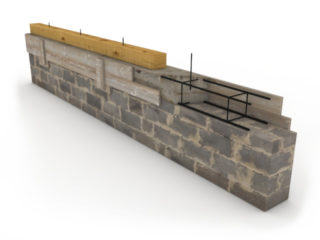
One of the criteria affecting the stability and durability of a building is the strength of its supporting structures. The strongest loads fall on the upper part of the outer walls, where their elements are held only by the binder solution and their own limited strength. To strengthen and fix them, a reinforced belt is installed under the roof. This structure is a one-piece contour of reinforced concrete, encircling the walls along a closed perimeter.
Armopoyas under the Mauerlat performs the following functions:
- compensation of spacer loads provided by the rafter system;
- maintaining the same level of aerated concrete blocks;
- prevention of cracks and wall deformation;
- even distribution of vertical pressure;
- reducing the level of negative factors associated with the shrinkage of the building;
- creation of a powerful and solid support for the installation of further structures - high walls, floor slabs, Mauerlat.
If the height of one level is more than three meters, a decision is made to install an intermediate circuit in its middle. This increases the construction budget, but significantly increases the sustainability and service life of the building.
The rafters are fastened to the base with studs, anchors or pins. The cellular material cannot be a reliable basis for their fixation and tight retention. Only reinforced concrete and analogs close to it in density can cope with such loads.
Features and sizing
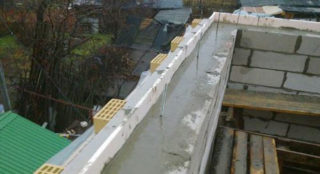
The dimensions of the armored belt are calculated at the design stage of the walls and roof structure. The best option is considered to be the same width of both structures. In this case, the minimum permissible value is considered to be 15 cm vertically and horizontally. If the distance between the walls exceeds 4 m, add 5 cm for each meter in proportion to its increase. This is due to the need to increase the strength as the horizontal and vertical loads on the supporting structures increase.
The same applies to pouring the armored belt into hollow profiles. If the building is being built from blocks 20-30 cm thick, this option is not suitable here. A contour equal in width should be installed over the entire surface of the main walls. This approach is good for the convenience of the subsequent finishing of the finished building. It is much more convenient to apply plaster on flat surfaces without drops.
Using bricks for making an armored belt
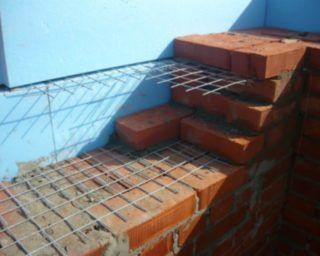
In some cases, with low-rise construction, it is allowed to make an armopoyas from a brick under a Mauerlat. This choice is justified in all respects when hanging rafters are used in the construction of the roof frame.These structures exert only vertical pressure, without any bursting loads on the walls. As practice has shown, brickwork is able to withstand enormous weight, while maintaining its shape and size. In addition, brick has much better thermal insulation properties than concrete. Such an armored belt will not be a source of condensation and cold bridges.
To attach to the Mauerlat, reinforcing pins are used, which are embedded in the masonry to a depth of 3-4 rows. An even better way is to install ties with nuts. Such fasteners are more expensive, but stronger and easier to assemble. The protruding end of the pin should be 25-30 cm longer than the height of the bar. To optimize construction, the pitch between the pins is taken so that the rafter legs can be attached to them.
Armopoyas device technology for Mauerlat
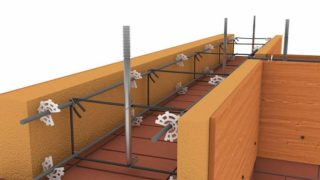
The installation of an armored belt consists of several stages, the first of which is drawing up a diagram, carrying out calculations and preparing equipment.
For work you will need:
- concrete mixer;
- Bulgarian;
- roulette, level;
- putty knife;
- hook for knitting wire;
- sledgehammer, hammer;
- electric drill;
- wrench;
- reinforcement 6-12 mm;
- paint brush;
- metal corrosion agent;
- masking tape.
After preparing the tools and materials, you need to wait for good weather and start building an armored belt.
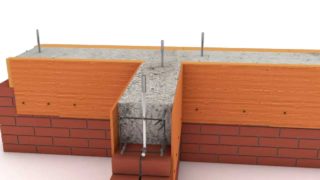
This is done in the following sequence:
- Formwork installation. For a fixed system, polystyrene modifications are used. For removable - plywood, boards, sheet steel. Fastening of the form is carried out with through ties, inclined pins or with the help of bars installed inside the sides. The formwork must be treated with hydrophobic agents so that concrete does not stick to it.
- Reinforcement cage creation. A skeleton is made from longitudinally located 10-12 mm rods tied to frames of 6-8 mm wire. It is recommended to tie the reinforcement with annealed wire, not using welding. It is better to create corners with the help of shaped parts with sides of at least 80 cm. The best option is to switch the outer direction to the inner one and vice versa.
- Pouring with concrete. For armopoyas, it is better to use a mixture of sand, fine gravel and cement in a ratio of 3: 3: 1. The mold should be filled continuously so that unconnected layers do not form, which leads to a decrease in strength. During the pouring process, air must be removed from the solution using a steel rod or vibrator. At the end of the process, the concrete is leveled with a spatula.
It takes up to four weeks for concrete to harden, depending on the air temperature.
There are several practical ways to secure the Mauerlat: on studs, pins, or using corners. In each case, the fixing method is selected individually based on the characteristics of the building or an extension to it.









some kind of kick. You have seen a five-story building or a 9-story building where the murlat is mounted on the armrobelt, what kind of nonsense. Armopoyas for laying the murlat does nothing in terms of reinforcement, tk. it lays down on the base of the wall, then its strength will also depend on the material of the folded wall, this is a divorce. Armrobelt is needed in the foundation pit during the construction of the foundation